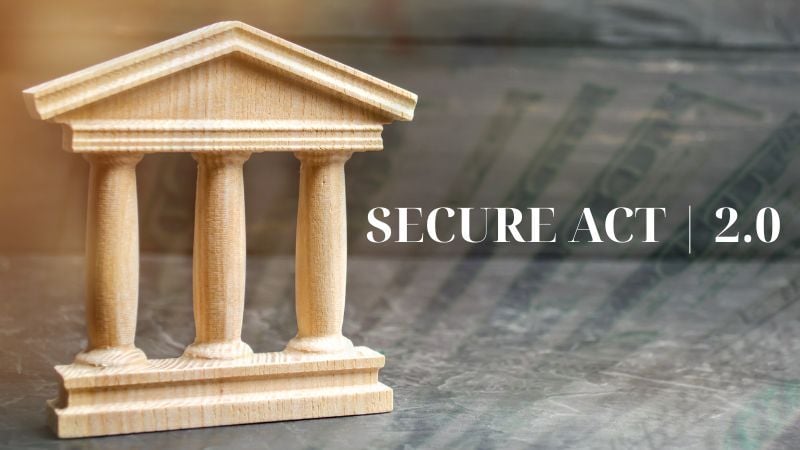Secure Act 2.0: Navigating 92 Provisions of Retirement Plan Changes
For our final session of the 2025 Higher Education Summit webinar series, I was pleased to welcome Dan Bowman, partner and Employee Benefit Plan Administration practice leader at Brown Edwards, to discuss the massive changes brought by Secure Act 2.0. As Dan noted, if we added all retirement plan law changes from 1999 to December 2022 and doubled them, we still wouldn't reach the scope of Secure 2.0's impact.
The Scale of Change
Secure 2.0 introduced 92 provisions - a staggering number that, as Dan frankly admitted, makes some retirement plans "practically unadministerable." The complexity is such that we often know more about what we don't know than what we do know about these provisions.
For context, the name "SECURE" stands for "Setting Every Community Up for Retirement Enhancement" - useful trivia for your next retirement plan discussion!
Key Contribution Limits for 2025
Before diving into Secure 2.0 specifics, Dan provided crucial baseline information about 2025 retirement plan limits:
- 401(k) elective deferral: $23,500 (remember, this is per taxpayer, not per plan)
- Catch-up contributions (age 50+): Additional $7,500
- Total annual addition limit: $70,000 ($77,500 with catch-up)
- Maximum compensation considered: $350,000
Dan emphasized an important tax strategy point: retirement plan contributions reduce your highest marginal tax rate first, making them extremely valuable for tax planning.
Major Secure 2.0 Changes
Required Minimum Distributions (RMDs)
The age for beginning RMDs has shifted from 70½ to 73, with future increases to 75 planned. The penalty for missing RMDs decreased from 50% to 25% - though Dan suspects this reduction might signal increased IRS enforcement rather than leniency.
New 72(t) Exceptions
Additional exceptions to the 10% early withdrawal penalty now include:
- Emergency expenses: Up to $1,000 for unforeseeable financial needs (remarkably broad definition, employee-certified)
- Domestic violence: Up to $10,000, with repayment options within three years
- Terminal illness: When physician certifies reasonable expectation of death within seven years
Enhanced Catch-Up Contributions
A new "super catch-up" allows individuals aged 60-63 to contribute $11,250 in additional catch-up contributions (150% of the normal catch-up amount).
Roth Catch-Up Requirements
Here's where complexity really emerges: starting in 2026, anyone earning over $145,000 in the prior year must make their catch-up contributions as Roth (after-tax) contributions. This creates significant administrative challenges for payroll systems and plan administrators.
Tax Credits: Real Money for Employers
Secure 2.0 significantly enhanced tax credits for starting retirement plans:
- Startup costs: Up to $5,000 credit for the first three years of plan fees
- Employer contribution credit: Credit for employer contributions up to $1,000 per eligible employee (under $100,000 income) for the first five years
Dan shared a real example from their Newport News office where the credit totaled $42,000 - "real money" that makes retirement plans much more attractive for business owners.
Administrative Challenges
Several provisions create what Dan calls "administrative nightmares":
Student Loan Matching
Employers can now provide matching contributions based on employee student loan payments. While well-intentioned, this creates complex tracking requirements and upends traditional plan testing assumptions.
Roth Employer Contributions
Employees can now elect to treat employer contributions as Roth (after-tax), creating complex conversion and reporting requirements.
Long-Term Part-Time Employees
Employees working 500+ hours for two consecutive years must be eligible for deferrals (though not employer contributions), adding another layer of eligibility tracking.
Auto-Enrollment Mandate
All new plans adopted after December 29, 2022, must include auto-enrollment and auto-escalation features, starting employees at 3% deferrals and increasing to a maximum of 15% over time.
State Mandates: The Retire Path VA Example
Dan highlighted Virginia's Retire Path VA as an example of state-mandated retirement programs for employers with 25+ employees who don't offer retirement plans. Multiple states have adopted similar mandates, with more likely to follow.
Dan's Contribution Reality Check
Dan concluded with his signature "pet peeve" demonstration, mathematically proving that Roth versus traditional contributions have nothing to do with age and everything to do with tax rates. Using his "associative property of multiplication" example with our volunteer participants, he showed that identical tax rates produce identical outcomes regardless of when you pay the tax.
Planning Recommendations
Given this complexity, Dan strongly recommends:
- Deliberate adoption decisions: Not every Secure 2.0 provision needs to be adopted
- Robust conversations: Discuss administrative implications before implementing new features
- Professional guidance: The complexity requires expert assistance for proper implementation
- Documentation updates: Plan documents need careful revision to incorporate desired provisions
Looking Ahead
While Secure 2.0 offers many positive enhancements for retirement savings, the administrative complexity cannot be understated. As Dan noted, some provisions that seem beneficial on the front end create significant backend challenges.
The key is thoughtful, strategic adoption of provisions that truly benefit your participants while maintaining administrative feasibility. Not every option needs to be implemented, and careful consideration of the long-term administrative burden is essential.
I want to thank Dan for his expertise and candid assessment of these changes. His practical insights help us navigate what could otherwise be an overwhelming landscape of new rules and requirements. As always, the best approach is careful planning with qualified professionals who understand both the opportunities and challenges these changes present.

